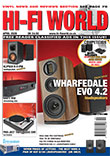|
From Hi-Fi World - July 2008 issue Open Baffle
In this quick resume Peter Comeau discusses Open Baffles and bass output. Since it has been a few months from the last epistle in the Speaker Design series I think I just ought to go over a couple of points with regard to generating bass from Open Baffles. The key point is that the output of an Open Baffle speaker will begin to fall below the frequency at which the baffle's shortest dimension - width or height - is a half wavelength. Normally, then, you would be expected to build a very large baffle in order to generate sufficient power down to, say, 40Hz. This would indeed be the case if we were using the baffle in free air. But in practical installations there are three factors which come to our aid. One is room gain. The boundaries of a room reflect bass frequencies very well, or at least they do if they are fairly solid as is the case in most UK houses; (in N. America you can generally expect there to be more bass ‘leakage’ from a room because of Dry Wall construction methods). As the frequency drops so room gain increases, normally at a factor of 6dB per octave below, say, 120Hz. Those boundaries can also be used to ‘extend’ the baffle. For example the floor is a natural extension of one side of the baffle and, if the room is not too wide, the side walls can extend the baffle on another side. The third factor, and the one that is least understood, is the effect of the Qts of the driver on the response as it approaches the natural fundamental resonant frequency (Fs) of the bass drive unit. Now I touched on this in the previous article and noted that it really needed some experimentation to find out what was actually going on. For a drive unit to aid the frequency response down to its Fs it would, theoretically, require a Qts of 1 or greater. These high Qs are difficult to find amongst typically hi-fi drive units which have, after all, been basically developed to suit bass reflex, or at best closed box, designs. But when we turn to the Pro driver market we find a few drivers which meet this criteria. The brand often chosen by OB DIYers is Eminence, and with good reason. This manufacturer includes large diaphragm bass drivers with high efficiency and high Qts figures, both of which are a boon to our OB calculations. I’ve chosen two sets of drivers to find out whether the high Qts theory really does work in practice. One set comes from the Eminence Alpha range and the other from the Beta range. For the baffles I have in mind the 15” drivers look the most suitable.
Eminence Alpha 15” driver, Fs of 41Hz and Qts of 1.26, LF sensitivity 94dB. What’s the difference between the Alpha and Beta range? Simply the size of magnet and, therefore, the overall Q value. As the magnet flux in the gap becomes stronger so does the damping effect of the magnet on the voice coil. Of course this damping effect is normally considered a ‘good thing’ because it helps control the drive unit when it is being pushed and pulled by the amplifier and thus helps deliver a more articulate bass performance. With a small magnet the drive unit diaphragm is more freely able to move and may not be under the full control of the amplifier at low frequencies. Indeed, as frequencies approach the fundamental resonance the speaker may begin to ‘boom’ or, at least, it will begin to be more difficult to ascertain exactly what a bass instrument, like drums, bass guitar or synthesiser, is actually playing. Somewhere in between must lie the nirvana of the Open Baffle design. The question is will it be with a Qts of 1 or more (Alpha series) or a somewhat lower value of 0.6 (Beta series)? When I started testing these drivers I quickly found that the answer is not straightforward, which probably explains why there is no ‘right way’ or ‘wrong way’ decision to be made when selecting drivers like these for your OB design. Here’s what I’ve found so far. Placed on a true open baffle the Alpha 15” with a high Qts of 1.26 certainly produces the most level bass. Output falls gradually, but slowly, below the baffle cut off frequency with the driver resonance helping to give it a ‘kick’ upwards as it reaches F0. Put in a room of moderate dimensions, however, and the apparent advantage of the high Qts drivers no longer seems so clear. Yes, the bass output is maintained strongly with good extension but articulation is blurred. Substituting for the Beta 15”, with the lower Q of 0.58, brings much of the bass clarity back but with less subjective bass extension. This is on a plain baffle stuck in a room, however, without tweaking to optimise room gain. I’ve a plan to maximise the bass output in any room which I’ll be covering next month as there is a lot of work yet to be done before I can make sure it works as well as intended!
Beta-15 Eminence Beta 15” driver, Fs of 35Hz and Qts of 0.58, LF sensitivity 96dB. |
Search
Hi-Fi World, Powered by Joomla!; Hosted by Joomla Wired.








